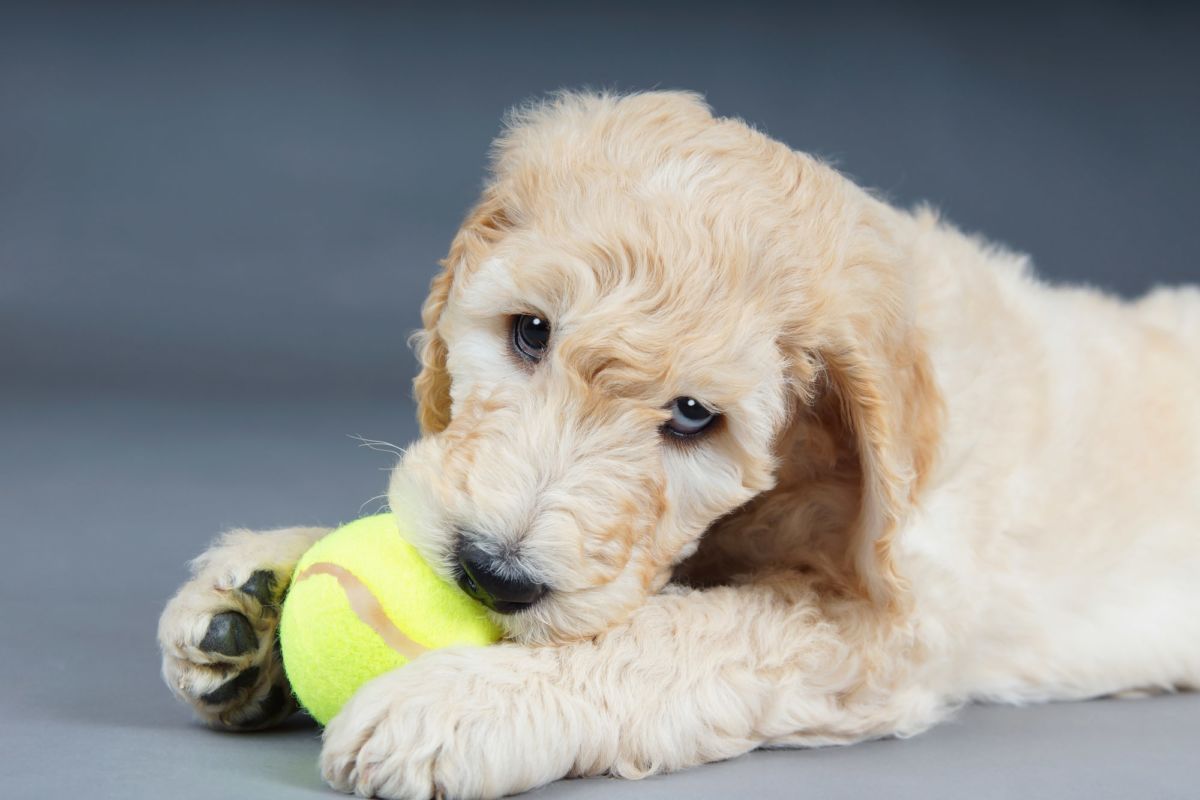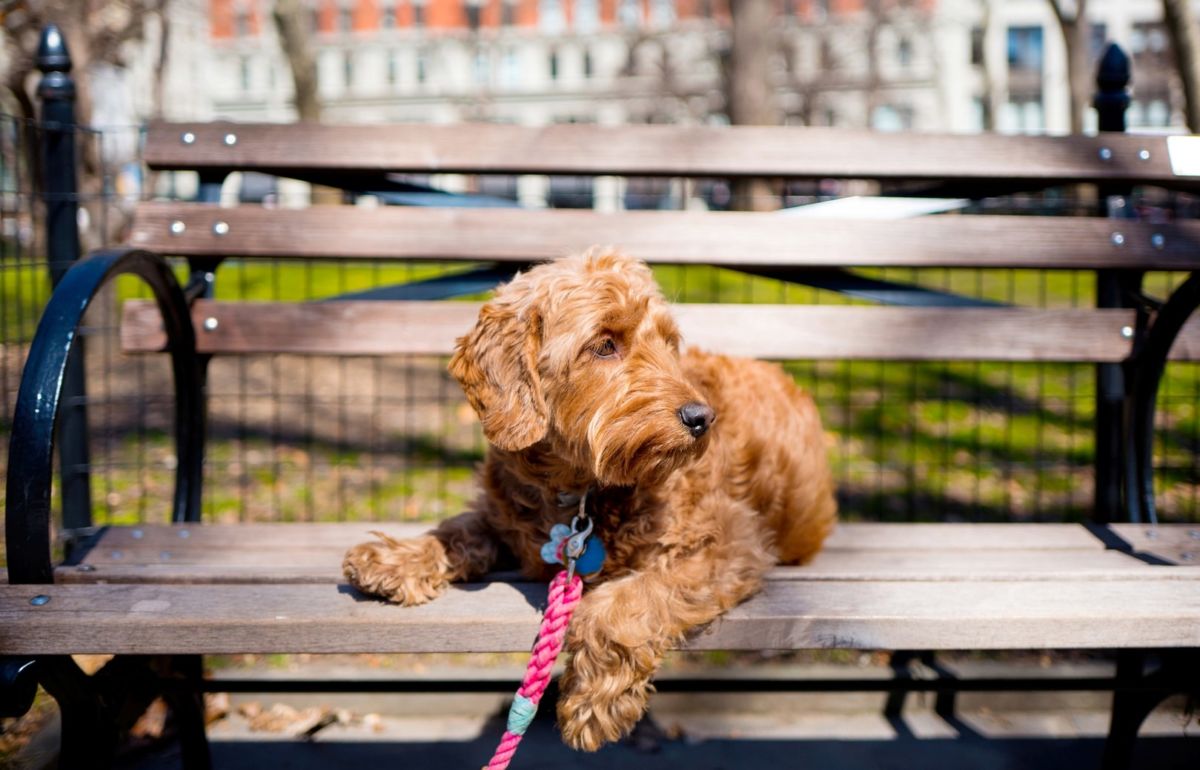Your Goldendoodle daily schedule has the biggest impact on how it behaves as an adult goldendoodle. Every detail matters. The time you take your pup for a potty break, the time they fall asleep, how much sleep they get and whether you spend quality time all shape your pup’s behavior. Of course, each young pup is unique and has its own quirks and personality, but this article can help you inspire good behavior in your beloved pet.
Continue reading to discover a sample schedule and training plan, plus tips and advice on how doodle puppy owners can get the most out of the process.

Essential Goldendoodle Puppy Tools
Depending on how you choose to train your doodle, the following tools and equipment will make getting into a happy, healthy routine easier:
- Clicker
- Special chew toys or treats for rewards
- Leash
- Collar and harness
- Crate
- Pet gate
- Blankets and soft things that are exclusively for your puppy
Goldendoodle Sample Puppy Schedule
When you get a new puppy, the first thing to plan is their daily puppy schedule. Ideally, you’d have this mapped out in advance before welcoming a goldendoodle puppy into your home. The more prepared you are, the more relaxed and confident you’ll be, which is crucial for effective training. Put simply, the more patient you are, the more effective you’ll be.
Training should start from day one and remain consistent throughout your dog’s entire life. By demonstrating that training is a lifestyle and not a superficial exercise, you make it easier for your pup to understand what’s expected of it. Your behavior and attitude shape your puppy’s, and if you don’t consistently and kindly discipline and reward it when necessary, it won’t behave as you expect.
Let’s take a look at how an ideal doodle pup’s day would look.
7:00 a.m.
Puppy wakes up, has the first of its potty breaks and enjoys some time playing with you and in its crate. Playing regularly in its crate helps promote a positive association.
7:30 a.m.
Time for breakfast — ideally at the same time as your own breakfast to avoid it begging and getting told no first thing in the morning. Take your puppy for a walk immediately after breakfast so it can go potty and let off steam. Finish off with crate playtime and then nap time.
10:30 a.m.
Take it straight for a potty break when it wakes up, then spend some quality time playing and training. Finish off with a potty break and nap in the crate.
12:30 a.m.
Lunchtime! Follow up with a potty break and unstructured playtime, then back outside for another potty break and back into the crate for a nap.
3:00 p.m.
It’s potty time again, then more unstructured play, another potty break and (you guessed it!) another puppy nap.
5:30 p.m.
Take your puppy for a potty break and do a quick bit of important training before dinner so you can use food as positive reinforcement. Ideally, take it for a walk after dinner so it can go potty and burn off some energy. Let it play or nap in the crate for a while when you return so it can wind down.
7:30 p.m.
Potty break, then playtime and finish off with some crate play and nap time.
9:00 p.m.
Potty time again. Then unstructured play followed by a short bout of crate training, finished up with a potty break and nap.
10:30 p.m.
After another bathroom break and small walk, it’s time for bed.
2:00 a.m. to 7:00 a.m.
Depending on your goldendoodle puppy’s age, you’ll need to wake up at least twice overnight to take your dog for a potty break. This continues until it’s fully potty-trained.
Tips for a Good Routine
While it’s easy to get frustrated with a puppy, the way it responds to training is ultimately your responsibility. Below are some tips to help you and your doodle get the most out of the process:
- Use meals as motivation for training! Rewarding your dog with food is the best way to reinforce good behavior, but offering endless snacks and treats is a recipe for disaster.
- Be as consistent as possible with the routine to make it easier for your puppy. It’s learning about the world and bound to make plenty of mistakes, but your patience and consistency are what help it understand your expectations.
- Overestimate how much training you need to do rather than underestimating it. You’ll be so grateful you did once it’s an adult.
- Always go potty after waking up. This helps it understand when its next potty break is coming
- Aim to take your puppy for a bathroom break every one to two hours while house training to prevent accidents.
- Keep meal times as consistent as possible and in line with your own meals. Not only is this important for its circadian rhythm and immune system, but it makes eating a fun, social activity instead of an opportunity for it to sneak food from family members.
- Keep exercise sessions short and sweet to prevent overwhelming your doodle pup while it’s still growing.
- Puppies can sleep for up to 18 hours a day, and this time is crucial for their growth and development. Avoid waking a sleeping puppy when possible and maximize the amount of time it spends napping.
- Keep bedtime as consistent as possible to minimize anxiety and promote a consistent, predictable routine your pup will thrive in.
Use Training to Gradually Shape Your Pup’s Behavior
Getting goldendoodle puppies into a great routine requires time, effort and plenty of room for error. Make sure the whole family knows the schedule-based rules and understands what’s helpful and unhelpful during training. The first few weeks will set the tone for your pup’s entire life, so work hard to get it right and you’ll reap the rewards for years to come.
Start off small, and as your puppy grows, spend time on more complex things and increase the length of training sessions.
Eight to 10 Weeks
Many puppy owners bring their new pet home around this age, and your focus should be on the basics:
- Maintaining a consistent daily schedule
- Potty training
- Name recognition
- Crate training and thresholds
- Redirect chewing and mouthing
- Basic commands: sit and come
- Early socialization: close friends and family
10 to 12 Weeks
At 10 to 12 weeks, you can start teaching more complicated commands and introducing the concept of impulse control:
- Introduce new commands in the home: heel, down and place
- Practice impulse control: food and water bowl
- Start using a leash and harness
- Doorway thresholds
- Socialization: common sounds
Three to Four Months
During this stage, your puppy can start training for longer periods and getting into more complex routines using the commands it’s picked up:
- Commands: stay and leave it
- Start extending sit and stay commands and combining some together
- Practice heel in the backyard
- Introduce structured play sessions
- Start socializing with new pups once your pet is vaccinated — just make sure they have a similar temperament to your puppy
Four to Six Months
Now you can start working on commands outside and take socialization to the next level:
- Practice commands outdoors and add in distance, duration and distraction mitigation
- Extend walks and solidify leash training and the heel command
- Start introducing toys and praise as rewards instead of food
Six Months to One Year
Once your puppy has basic commands down and is well-socialized, you can’t stop the routine! Ideally, your pet’s schedule should remain as consistent as possible throughout its lifetime, just with less structure as it gets older. There might be days or even weeks when it seems to regress, but as long as you stay calm and stick to the training schedule and daily routine, your doodle puppy will thrive.

Effective Goldendoodle Puppy Obedience Training Methods
Every puppy is different and responds uniquely to stimuli, so there’s no one-size-fits-all when it comes to training methods. Remember, the younger your pup is, the shorter its attention span and the less it understands. A lot of the earliest work involves planting seeds for the future and maintaining that consistent routine. Once it gets to four to six months, it’s time to introduce more formal training.
Many goldendoodles respond best to one or more of the following methods:
Positive Reinforcement
Your number one tool as a puppy parent is positive reinforcement. Scolding and punishment will make it fear you, which might garner very short-term results but will ultimately lead to long-term problems like destructive behavior, biting and excessive barking.
Be enthusiastic and full of praise every time your doodle pup does something right, and use a calm yet firm “no” and then ignore any unwanted behaviors. Use a mixture of praise and toys as your primary rewards, with food used as big rewards and treats very occasionally.
Lastly, your dog primarily wants your attention and can’t necessarily distinguish between excited praise and anger. Responding enthusiastically to unwanted behaviors (even if you’re enthusiastically unhappy) will reinforce the behavior you’re trying to prevent.
Clicker Training
Many puppies respond best to clicker training, and many professionals use it. It combines positive reinforcement with a handheld clicker that you press whenever you reward your pet for following a command or behaving well. Very quickly, it starts associating the click with a reward, until the clicker itself becomes the reward and a treat is no longer required.
Crate Training
Crate training provides a secure, safe place for your doodle to relax and call its own and no one else’s. Animals are territorial by nature, and giving your pup a little island of its own in your home is a great way to prevent unwanted behaviors. With some doodles it might take a few days, while it can take weeks with others, but it’s always worth it.
Remember, the crate is not a punishment. The moment your pet makes a negative association with its crate, it won’t be effective. Only leave it in there for a maximum amount of hours that’s equal to its age in months, stopping at a maximum of six to eight hours.
Common Training Problems Goldendoodle Owners Should Know About
Doodles are some of the cutest, most loving and most affectionate dogs in the world. However, like every breed, they have their character quirks. Below is a list of the main issues doodle owners encounter and how to approach them.
Jumping
All dogs have the potential to get excited and jump up on people when they meet or greet them, but this can be scary for strangers and children. Teach your doodle puppy that it only gets a reward if it sits when greeted and this behavior will eventually become second nature.
Stealing Food
Every dog loves to eat. However, overeating and obesity impacts their quality of life and can take years off your pet’s life span. Ensure counters are clean and clear of food when you’re not there and trash cans are out of reach. When it’s young, it might be best to put your puppy in its crate while you prepare food, but sit, off, stay and leave it commands can be used when it’s ready.
Leash-Pulling
Your doodle puppy will adore walks and be super-excited to explore every time it’s out — which is why leash-pulling is often an issue at first. To combat this behavior, immediately stop walking and only begin again once it’s stopped pulling. A clicker can be particularly good for this behavior.
Mouthing and Biting
Biting is natural for dogs, and they might use it as a way to get your attention in addition to it being a sign of aggression. Use chew toys to redirect the behavior, and make sure you’re giving them enough exercise, playtime and affection.
Pre-Trained Goldendoodles Puppies For Sale
At Pride & Prejudoodles, we help with the hardest work initially so that you can pick up training from a professional at three or five months old. Check out our training program to find out more.
